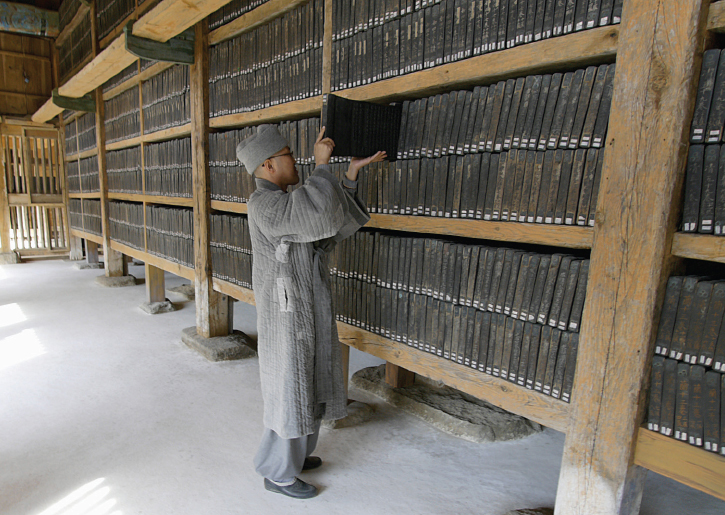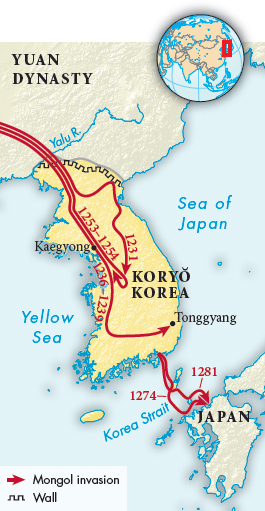Understanding World Societies:
Printed Page 375
> How did Korean society and culture develop in an age when its northern neighbors were Khitans, Jurchens, and Mongols?
DDURING THE SILLA PERIOD, Korea was strongly tied to Tang China and avidly copied China’s model (see “Korea” in Chapter 7). This changed along with much else in North Asia between 800 and 1400. In this period Korea lived more in the shadows of the powerful states of the Khitans, Jurchens, and Mongols than of the Chinese.

The Heainsa Buddhist Temple in Korea has preserved the more than eighty thousand woodblocks used to print the huge Buddhist canon in the thirteenth century. The monk shown here is replacing a block. All the blocks are carved on both sides and stabilized by wooden frames that have kept them from warping. (© OUR PLACE THE WORLD HERITAGE COLLECTION, www.ourplaceworldheritage.com)
The Silla Dynasty began to decline after the king was killed in a revolt in 780. For the next 155 years, rebellions and coups d’état followed one after the other, as different groups of nobles placed their candidates on the throne and killed as many of their opponents as they could.
The dynasty that emerged from this confusion was called Koryŏ (KAW-

The founder of the dynasty, Wang Kon (877–
At the other end of the social scale, the number of people in the serf-
The commercial economy declined in Korea during this period. Except for the capital, there were no cities of commercial importance, and in the countryside the use of money declined. One industry that did flourish was ceramics.
Buddhism remained strong throughout Korea, and monasteries became major centers of art and learning. As in Song China and Kamakura Japan, Chan (Zen) and Tiantai (Tendai) were the leading Buddhist teachings (see “Tang Culture” in Chapter 7). The founder of the Koryŏ Dynasty attributed the dynasty’s success to the Buddha’s protection, and he and his successors were ardent patrons of the church. The entire Buddhist canon was printed in the eleventh century and again in the thirteenth. As in medieval Europe, aristocrats who entered the church occupied the major abbacies. Monasteries played the same roles as they did in China and Japan, such as engaging in money-
The Koryŏ Dynasty was preserved in name long after the ruling family had lost most of its power. In 1170 the palace guards massacred the civil officials at court and placed a new king on the throne. After incessant infighting among the generals and a series of coups, in 1196 the general Ch’oe Ch’ung-
Korea, from early times, recognized China as being in many ways senior to it, but when strong non-
As mentioned in Chapter 12, Korea was conquered by the Mongols, and the figurehead Koryŏ kings were moved to Beijing, where they married Mongol princesses, their descendants becoming more Mongol than Korean. This was a time of hardship for the Korean people. In the year 1254 alone, the Mongols enslaved two hundred thousand Koreans and took them away. Ordinary people in Korea suffered grievously when their land was used as a launching pad for the huge Mongol invasions of Japan. In this period Korea also suffered from frequent attacks by Japanese pirates, somewhat like the depredations of the Vikings in Europe a little earlier (see “Invasions and Migrations” in Chapter 14).
When Mongol rule in China fell apart in the mid-
>QUICK REVIEW
How did Korean society differ from Chinese society in this period?